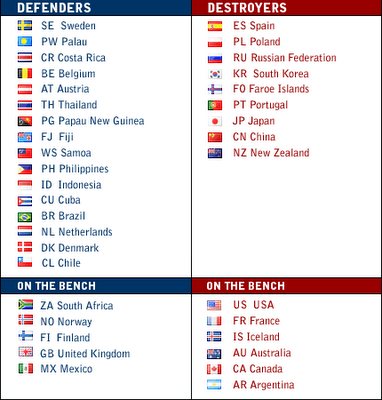Thursday, July 27, 2006
A picture paints a thousand words...and this one paints a very sad picture.

This is an image of Israeli school children writing messages on shells destined for Lebanon.
Wednesday, July 26, 2006
Karori Sanctuary worthy of support


Press Release from Russel Norman Green Co-Leader and Sue Kedgley Green MP
26th July 2006.
This morning Green Co-Leader Russel Norman joined with other parties in
draping signed green ribbons on Lambton Quay supporting the Karori wildlife
sanctuary.
The Karori Wildlife Sanctuary missed out on funding for a new visitor centre
from the $32 million Community Based Projects Fund, despite Prime Minister
Helen Clark saying that the visitor centre “was the sort of project the fund
aimed to help.”
“The Karori Sanctuary is an amazing place. Only two kilometres away from the
CBD you can be surrounded by our unique flora and fauna and have the chance
to see our threatened national icon – the kiwi,” the Wellington based Dr
Norman says.
“The sanctuary is a world-first and the predator proof fence allows
threatened species such as the little spotted kiwi, saddleback and the
tuatara a safe haven on New Zealand’s mainland.”
“This is essential both as a needed conservation measure but also to provide
urban dwellers and tourists the opportunity to get up close to our unique
flora and fauna and see why it is vital to protect our natural toangas,” Dr
Norman says.
“I would like to see what’s happening in Karori replicated around the
country and see more urban sanctuaries established,” he says.
Green Party MP and spokesperson for Wellington issues Sue Kedgley points out
that the Sanctuary is another draw card in attracting tourists to the
Wellington region.
“It’s an absolute scandal that the award winning and popular sanctuary has
missed out on funding with $13 million of the fund still unallocated,” she
says.
“What’s the point of the fund if it’s not going to deserving applicants like
the Karori Sanctuary,” she asks.
“The Sanctuary clearly has massive community support from its members, local
Government and also the 250 000 volunteer hours that have been put in. The
Government should acknowledge all that hard work and support this
much-needed conservation and tourist venture.
“The visitor centre is estimated to triple visitor numbers to 170 000 and is
vital to Wellingtons tourist industry and will provide the region with more
good quality jobs.”
Tuesday, July 18, 2006
Busways and Bus Rapid Transport: The International and New Zealand context.
Introductions
Bus rapid transit (BRT) is a broad term given to a variety of different transportation systems involving buses and ranges from:
● Dedicated exclusive busways such Curitiba (Brazil)
● Buses operating in high occupancy vehicle lanes or in mixed traffic, such as in Houston, LA, Ottawa.
● Dedicated busways with some form of guidance such as in Essen or Adelaide’s O-Bahn.
● A mix of initiatives such as signal prioritisation, off-bus fare collection, level boarding upgraded and or well spaced bus stops and real time information services, such as LA’s MetroRapid.
BRT is a fuzzy concept that could broadly be argued is any bus measure above basic normal on-street operation.
This study will be investigating bus measures internationally with a focus on exclusive busways as is proposed for Wellingtons Northern Corridor.
BRT is an old concept and was apparently first proposed in Chicago in 1937, however the first exclusive busway was the El Monte Busway in LA; opened in 1972, then opened to cars containing 3 then 2 or more passengers in 1974 which caused severe congestion.
BRT is often portrayed as “like rail;” or “rubber rail;” however without the cost. Which asks the obvious question – if it’s so much like rail – why not just build rail to start with?
Advantages of BRT
Busways and BRT are perceived to have positive effects on road congestion and are seen to improve this, cheaper than light or heavy rail can. Busways are often cheaper in the short term because of lower vehicle capital costs; they utilise existing streets and road maintenance costs are usually externalised.
Busways are seen as being more flexible and responsive to population changes. They can provide seamless travel, reducing the numbers of transfers, from a distant suburb to the city; with roving buses driving through normal streets picking up passengers until they join the express busway to central destination.
Busways can be built incrementally and extended as desired.
The International situation
Just this week two large bus BRT projects internationally have been turned down in favour of light rail alternatives – In Minneapolis and Seattle.
To start with it is best to look at the home of BRT Los Angeles.
Los Angeles.
LA’s El Monte busway opened in 1973 and was moderately successful peaking with ridership at 30 000 per day, however opening the busway to high occupancy vehicles (HOV) and resulting congestion resulted in a 33% reduction in passenger
-ship.
1997-2000 LA opened the Harbour Transitway, an 11km stretch of mixed bus and HOV for approximately $500 million, and whilst there is debate on the passenger figures there is consensus that it is low; below predictions, and substantially less than the near-by LRT.
LA’s Metro Orange Line is a dedicated busway that curiously is classified as a rail network and is given a colour coding. This busway was opened recently and is still under construction. The project has been plagued by work disruptions and the busway has seen numerous crashes both as a result of bus driver error and vehicles ent
ering the busway.
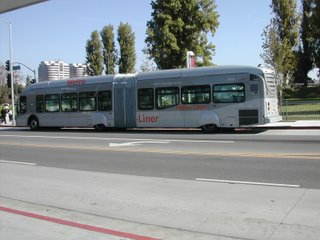
LA’s silver line – a ‘train-like-bus,’ where buses are painted the same colour as the train and are officially part
of the train network.
Ottawa.
Ottawa’s Transitway is the largest project in the City’s transportation history and has been honoured with a Canadian Public Works Project of the Century Award. A dedicated system of bus-only roadways, the Transitway provides an exclusive rapid transit link across much of the City’s urban area, with service operating 22 hours a day. Ottawa’s busway is often cited as the best example internationally; however it is troubled by congestion at city entrances; fares had to be reduced to encourage usage and passenger trips per year has dropped by 1 million since completion.
Ottawa in 2001 built an experimental light rail network, the O-train. One criticism is that the trains receive very low ridership compared to some very crowded bus lines. It should be noted, however, than one fully loaded O-Train carr
ies 285 passengers compared to 131 passengers for buses
Adelaide
Adelaide’s O-Bahn busway opened in 1986 and is a guided busway that runs for 12 km. Built rather than the originally conceived light rail system, the busway has been moderately successful and has not seen the 25% reduction in passenger numbers since transport deregulation that other networks have. This has been ascribed to the fact that the busway caters to the growing northern suburbs. The O-Bahn encounters problems at the end of the busway when the buses join congested city streets.
Curitiba
Curitiba has, indeed, accomplished a lot on a limited budget and is often cited as the developing country, ‘city that could.’ Using novel approaches to transport planning Curitiba was able to drastically improve the efficiency of its bus fleet.
Prepayment of fares and level boarding, systems typically found in rail systems, create a very efficient boarding and deboarding process. A bi-articulated bus (a 5-door, 82-foot bus built by Volvo and currently used only in Curitiba) with a load of 270 people can board or deboard in about 20 seconds. The average speed o
f buses using the busway is 13 miles per hour--twice the estimated speed for buses operating in the same Curitiba corridors in mixed traffic.
There are five busways, each between 5 and 7.5 miles long, radiating from the city centre. The most recent busway was completed in 1994 at a cost of $1.5 million per kilometre. There are plans to add circumferential busways to link key suburban areas. Curitiba is a great example of a ‘like rail,’ BRT system with extensive ex
clusive busways, huge buses, more akin to trains; however the buses are considerably overcrowded and affected by increasing road congestion due to increasing affluence and vehicle use, Curitiba is considering other transport modes.
Auckland’s Busway
In New Zealand we have our very own busway nearing competition (2007); Auckland’s Northern Busway is estimated to cost in total 325.5million and will ccomprise a 6.0 km stretch of dedicated two-way roadway for buses in both directions and HOV lanes, having southbound access only in the morning peak, the planned two-lane busway will run between Constellation Drive and Esmond
e Road. Bus stations will be located at Albany, Constellation, Sunnynook, Westlake and Akoranga. A single 2.5 km lane busway will run southbound from Akoranga Station to the Harbour Bridge.
The busway has encountered controversy over the bus company tender process and has been criticised for not including cycle lanes or a bus lane on the harbour bridge, where congestion is expected to be high.
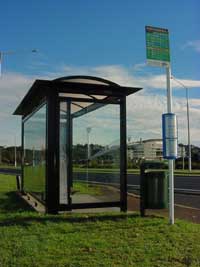
Depressing photo of what the Auckland busway website refers to as ‘Modern bus shelters.’
Disadvantages of BRT
One bus has space for about 50 passengers only; articulated or double decker buses may push the crush load capacity to about 100. Thus the BRT transport vessel has an intrinsic capacity limitation and finds its place on the capacity scale between standard bus services and rail-based systems. In Europe the bus driver's salary may account for 60-70% of the total operating costs. As one tram driver can drive the same number of passengers as 4-6 bus drivers, on high capacity routes BRT may not be the most cost effective solution.
BRT is often considered cheaper; and whilst construction and capital costs usually are, operating costs are not necessarily. In Boston operating costs per passenger mile of LRT was 32 percent cheaper than BRT; of rail, 50 percent cheaper (2002), and in LA their LRT was 24 percent cheaper than bus; rail rapid transit 22 percent cheaper.
When a dedicated roadway is only available for part of the bus journey the BRT system is still subject to traffic congestion especially at the entrances, such as in Adelaide, Ottawa and will be in Auckland. This considerably reduces frequency and reliability of service and can affect ridership levels as seen in LA or Ottawa.
As with truck traffic, heavy bus traffic with its high axle-load causes significant wear and tear of the road surface, and regular investment is required to maintain quality. This is a particular problem for guided busways, bus stops and similar situations where the wheels always pass exactly over the same spot, whereas rail lines can take considerable wear. A further argument against BRT is that the rolling resistance of rubber wheel on tarmac is many times that between steel wheel and steel rail (a factor of between 5 and 10 is often quoted).
BRT also suffers from images problems associated with buses. Some argue, they do not attract the ridership of rail lines, and it is not clear whether they can encourage secondary advantages such as neighbourhood revitalization and business development. Conversely, some South American systems claim capacity in the order of 40,000 passengers per hour per direction, levels that are consistent with some heavy rail, metro systems. Similarly, many more modest BRT systems may operate with daily ridership that equals or exceeds that of light rail LRT systems in other cities.
Environmentally, the majority of buses internationally are run on diesel and thus contribute to local pollution and climate change. I could not find any busways internationally that utilised trolley buses. Bus exhaust fumes also increase costs, where tunnels are part of the network; requiring large extraction fans to remove diesel particulates.
BRT on the Johnsonville line
Removing the rail lines is a step backwards and would place Wellington with other cities around the world that removed tram, trolley bus or train infrastructure and are now regretting the decision and finding the massive infrastructure costs to replace tram, trolley bus and train infrastructure prohibitive.
Trains can carry more passengers for the same price and are not subject to fuel price rises. In fact operating costs may be lower at higher frequencies.
The Johnsonville busway, unlike Auckland, will have to be a guided busway to ensure safety through the 7 tunnels; which under current investigations would be a very close fit with the possibility of buses fouling themselves on the tunnels. Adelaide’s O-Bahn is the likely model for guidance; however this reduces one of BRT’s advantages – its flexibility.
The busway is envisioned to be only a one-way system catering for the morning and evening commute to Wellington city, and does not provide for passengers who travel from Wellington to the Northern suburbs. It would be confusing and uninteligible for the general public who would have to figure out which way the rail was running at any particular time of the day. I could not find any busways internationally that used a single one-way lane. Planners gave up on the concept of a two way busway because it would be prohibitively expensive requiring massive earthworks and retaining walls. Rail currently provides two-way transport and as such provides a far superior service.
Having buses as the only transport mode for the Northern region would exacerbate already congested roads, especially on Lambton Quay, and would significantly increase road congestion – hardly a prudent public transport strategy. 30-40 buses an hour could be necessary for this route during peak hour to match the carrying capacity of rail, and this number of buses would result in peak congestion in Wellington city. Wellington city transport planners would have to bus-priority measures and in all probability close off some streets to traffic. This increased number of buses would increase pollution, noise and diesel emissions in Wellington city.
Construction of the busway would cause massive disruption to Northern residents and may take 12-18 months or longer. During these years commuters would switch to commuting by car and many would be lost to public transport forever. Hardly a sensible transport strategy.
Buses suffer from perception problems are the most unpopular form of public transport. This was confirmed by the feedback at the recent public meetings in Johnsonville. Buses unpopularity results from their deficiencies in speed, comfort and convenience compared with rail, and are also considered as a social accommodation – they are not chosen, but are ridden by passengers that are ‘transport dependent’ and don’t have other options. Edward Tennyson, U.S transport expert in his study of buses in the U.S. found that cities served exclusively by buses, passenger levels had reduced by 75 percent over 40 years; and in contrast, rail is likely to attract from 34 to 43 percent more riders than buses.
Another major flaw in the two bus based options is that it relies on fossil fuel based public transport. This is a major issue and must be addressed in the interests of sustainability. Public transport rates in the region have increased on average above 5% in 2006 as a result of increased fuel prices. Assuming that this current round of high oil prices is a temporary blip is neither: smart, future-orientated or sustainable. Diesel is a dirty, polluting and climate changing fuel source that comes from unreliable sources. The transport sector currently makes up 40% of our CO2 emissions in New Zealand and the Wellington region must do as much as possible to reduce its greenhouse gas emissions, both to help limit the risks of climate change and also as a matter of financial self interest to avoid fuel price rises and probable carbon taxes. Alternatives such as an electric-powered trolley buses or using alternative fuels such as bio diesel to power the buses are possible but would need considerable research first, whereas the enhanced rail and light rail options utilise existing technology and infrastructure and therefore are more desirable.
Conclusion
BRT and busways are a technology still in its infancy and there are no shinning examples internationally to act as a model for Wellington. Other cities such as Curitiba and Adelaide have a different operating context that is radically different from our situation of a small compact and steep corridor that would only allow one-way busways. Busways are applicable in some circumstances such as far-flung low density suburbs not in Wellington’s circumstances.
Wellington would be crazy to go down this path, especially since we have a fully operating, popular and affordable train network that is cheaper to improve rather ripping it up and building a new transport mode.
Monday, July 17, 2006
Bottom Trawlers: How Low Can they Go?
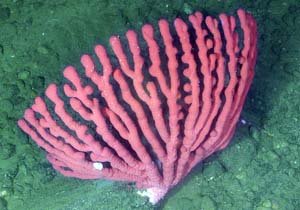
Roughly 2000m. Down this far down everything is pitch black; a human would be crushed under the enormous pressure; yet a myriad of weird and undiscovered sea life exists. Scientists estimate there could be 100 million species that are undiscovered in the ocean depths. The deep ocean truly is one of our last wildernesses – yet kiwi fisherman are taking part in one the largest destructions to occur on our planet.
Bottom trawling involves dragging large nets over the ocean floor with the ability to catch enormous concentrations of fish. In New Zealand fishers target species such as orange roughy and oreo. The ocean floor isn’t flat like most people assume, rather it has landscape features like the land and can alternate from rolling hills to steep mountains called ‘pinnacles’ by the fishermen and these mounts are rich fishing grounds. New Zealand is an ocean super-power and has the forth largest exclusive economic zone (EEZ) in the world, most of its comprising rich, rocky differentiated landscapes covered in lush coral and sponge growth. We have roughly 1000 undersea mountains and like on land these comprise many diverse ecological niches however because of the stillness and isolation half of all species are endemic to that mountain.
Sadly all but one of these mountains have been bottom trawled by, on average, 500m wide nets, with large metal rollers and 2–4 tonne ‘trawl-doors’ or ‘spreaders’ are dragged relentlessly up or down crushing and grabbing all in their path. Having sailed on the Rainbow Warrior in pursuit of New Zealand bottom trawlers in International waters I wit nessed a large man-sized coral ‘tree’ being dragged up and thrown overboard, and have heard anecdotally from former trawlers that for every 4 tonnes of orange roughy caught, 10 tonnes of coral will be brought up. Dead.
nessed a large man-sized coral ‘tree’ being dragged up and thrown overboard, and have heard anecdotally from former trawlers that for every 4 tonnes of orange roughy caught, 10 tonnes of coral will be brought up. Dead.
New Zealand’s bottom trawling story starts in 1979 when a Soviet exploratory trawler discovered a previously undiscovered fish that had amazing properties – it was in abundance; caused diarrhoea if not prepared correctly and yet could be freeze-thawed, freeze-thawed, making it a perfect export fish. From then on the gold rush was on; yet the fishermen knew little about the ‘slime-head’ (later to be called the more marketing-friendly, orange roughy), and only in 2003 was the first juvenile discovered. This discovery helped age most commercially caught fish at 150 plus years old, that’s older than your granny.
New Zealand pioneered much of the technology that is used for bottom trawling, and we are a world leader amongst the eleven nations that do 95% of the bottom trawling in International waters. We are leaders in destruction; having seen orange roughy populations plummet, leading to a recent closure of one third of New Zealand’s EEZ and much of the ocean floor ecosystems destroyed, leading to the biological extinction of our native umbrella octopus, who used coral as a base for its eggs.
We are vocal on Japan’s illegal whaling and were passionate opponents of drift net fishing yet we are doing little internationally to stop the destruction we are causing. The United Nations is the process of defining the future of bottom trawling in International waters and come December hopefully there will be an International moratorium in place. Before that happens our Government must stand up to aggressive lobbyists such as Sealord’s and Talley’s and be on the side of conservation. Recently large tracts of the Indian Ocean were voluntarily put off limits to NZ trawlers, cynically after we had fished to destruction most of it. Embarrassingly we are being trumped by George W. Bush who recently closed off Alaskan waters larger than the size of Texas to bottom trawlers.
We need our Government to support the moratorium on bottom trawling in International waters and you can write the Minister of Fisheries Jim Anderton and Foreign Minister Winston Peters urging them to be world leaders in marine conservation.
This is an article I wrote for Wellingreen. The pictures are from NOAA
who reccentlt presented damning evidence against bottom trawling.
Wednesday, July 12, 2006
Waste.

Waste is an important environmental issue, and if there were international awards for producing it – we’d be winners. Every day New Zealanders throw out ten million kilograms of it into landfills or burn it; producing a massive problem that has often been considered, ‘out of sight out of mind.’ The problem is not just where it goes – but also how much of it we are producing.
There are currently ninety landfill sites operating in New Zealand, taking a total of over 3 million tonnes of our rubbish each year. Whilst we have reduced the number down from 327 landfills in 1996, we are still faced with the problems that they are filling fast; are unpopular to live near; and produce the climate changing gas methane. Landfills also produce dangerous unintended by-products such as leachates; where water percolates through the landfill and produces one noxious brew. In old landfills, leachate can escape and contaminate surface and groundwater. In modern, well-managed landfills it costs a lot of money to collect and treat the leachate.
Burying our waste is not a solution and we can’t keep hoping it will go away. It won’t. A waste free society is essential to the well-being of people and the integrity and sustainability of the biosphere. Natural ecosystems are self sustaining and generate no waste. Humans form part of the ecosystem and while we access resources from our environment, we have a responsibility to return only those things that can be absorbed without detriment. Waste does not have to be an inevitable part of a modern economyl.
Green Party MP Nandor Tanczos has recently introduced the waste Minimisation Bill that would see the development of a national waste minimisation framework “with teeth” to enforce its implementation. The Bill contains a raft of changes intended to reduce the amount of waste created as well as promoting reuse and recycling whenever possible. Landfill waste levies would be introduced to help pay for a variety of measures including public education about recycling.
Minister for the Environment David Benson Pope has labelled the Bill, “…excessively detailed and prescriptive,” however the Labour Party has supported sending it on to the select committee; who have called for submissions with a deadline of August 4.
Currently waste issues are dealt with under the 2002 NZ Waste Strategy which has lots of good ideas but has failed to decrease the total amount of waste being sent to landfill because it is purely voluntary. Nandor’s Bill would see producers take responsibility for their products at the end of their life and waste generated in their manufacture; would see a levy put on waste going to landfills; would enables bans on landfilling of materials where there is already capacity to reuse, recycle or compost; and would set up a central body to oversee waste minimisation.
Introducing extended producer responsibility is an important step in the right direction to tackle our waste problem. Businesses which produce or import goods should bear the main responsibility for any waste associated with the goods – in their manufacture, packaging and use, and at the end of the goods’ lives. This way, producers would be encouraged to minimise and design out waste and to make reusing or recycling easier. For example today, Vodafone and Telecom accept used phones back and Hewlett Packard, Dell and IBM take back old computer equipment.
Tyre Track, in its first 18 months of operation disposed or reused 1.3 million old tyres, still every year we are disposing of 4 million old tyres. This principle of producer responsibility is essential to creating a sustainable economy; where less waste means less inefficient and expensive use of resources.
To find out more information about Nandor's Bill visit www.greens.org.nz/campaigns/waste and Nandor will be up at Vic talking about waste in the student union building, meeting room 3, at 1pm Thursday 20 July as part of environment week.
Tuesday, July 11, 2006
When to Stone Your Children...Really....Really depicted by lego men.
This is off a fantastic
website called the Bricktestament where a reverend has decided to depict the entire Bible with lego men, why? I'm not sure but he certainly had a lot of time.
The below pics are from Deuteronomy 21:18-21
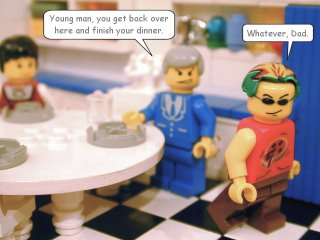
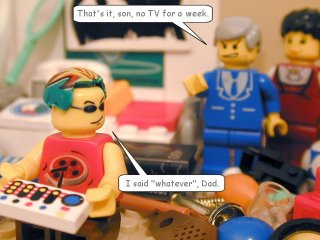
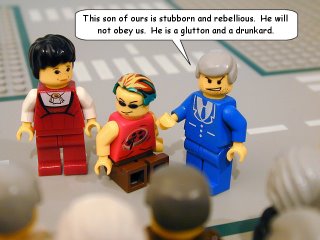
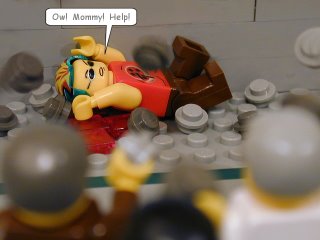
New Zealand Green Scene
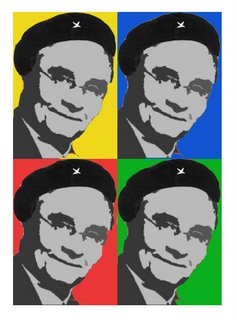
The New Zealand political situation is dominated by our MMP (Mixed member Proportional) system of Government; where we have the Governing Labour Party assisted by its left-allies the Progressives, and aided by right-leaning supporters: United Future and New Zealand First. The Green Party achieved 5.4 percent of the national vote in the 2005 election and came perilously close to dropping below the 5% threshold to have MPs in Parliament, as a result of a close vote between the two largest Party’s. The Greens vote was still good enough to get 6 MPs in Parliament but the Party was soon rocked by the sudden and tragic death of its co-leader Rod Donald. Despite the Greens and Labour campaigning together at the last election, Labour reneged on it’s possible and ‘publicly electioneered on,’ alliance with the Greens, and in stead turned right and offered Government positions to the other party leaders; leading to the novel situation where Winston Peters, leader of New Zealand first, is New Zealand’s foreign Minister; yet is not in the Governments Cabinet. The Labour Party has successfully navigated the MMP political environment and can turn to the greens and to introduce ‘progressive,’ legislation,’ or can equally turn to the right for legislative support, and now in it’s third term as Government demonstrated that it can play the political game better than anyone else.
The New Zealand Green Party has just elected its new co-Leader - Dr Russell Norman who replaces the late Rod Donald and ushers in a big change to the Greens Parliamentary leadership. Dr Norman, who has a PhD in political science was the Party’s development Coordinator and was the campaign manager during the last election. Other candidates who stood were MP Nandor Tanchzos; former MP Mike Ward and David Clendon, however Dr Norman had the votes at the Green Party AGM and joins Jeanette Fitzsimons as the Green Party of Aotearoa’s Co-leader however is now the co-leader outside of Parliament; making an interesting political experiment.
One of the biggest issues in recent months, saying a lot about New Zealand, has been a hard fought campaign over the question to compulsorily microchip dogs, and whether farm dogs should be exempted, leading to a Government back down and removal of the Bill.
Climate change has been a big issue in politics with the government expected to announce its climate change policy in a few months. New Zealand has a ridiculous situation where we have signed up to the Kyoto protocol yet have done nothing substantial to curb greenhouse gas emissions or even a Government policy on it. Former initiatives such as a carbon tax and a methane tax have been removed and with no initiatives or penalties to influence carbon consumption New Zealand look set to exceed its targets; and its previously forecasted $500 million carbon windfall looks set to cost the Government a $500 million penalty. New Zealand differs from many countries in that methane from animals is our largest source of greenhouse gases as agriculture forms a large part of our economy. The unfortunately named, ‘fart-tax,’ was the victim of a concerted lobbying campaign by opposition MPs and farmers, and now with it gone there is no climate policy.
This is an article I wrote for UK Young Greens
Friday, July 07, 2006
What Would Captain Ozone Do?
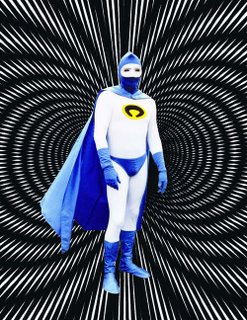
Hes fighting smog and environmental crime.
watch his documentary.
Thursday, July 06, 2006
Countries that support an international moratorium on bottom trawling
Bottom trawling ‘ban’ is cynical PR spin
News that four large fishing companies, including New Zealand’s Sealord, are to voluntarily cease the destructive practice of bottom trawling in parts of the Southern India Ocean has drawn a sceptical response from Green Party Conservation Spokesperson Metiria Turei.
“In theory, it is great news that fishing companies are taking the initiative and imposing voluntary standards on themselves in this area, as any measures to reduce or end the harm causing by bottom trawling in the long term will need industry buy-in if they are to be truly successful,” Mrs Turei says.
“However, while it may sound positive at first, it is hard to get excited about this announcement when you consider that the area in question is already severely over-fished. It is not much of a sacrifice to cease fishing of an area with no fish left in it.
“In fact, it is hard to see this initiative as anything more than an attempt to deflect the international community from imposing any real restrictions, like a ban on bottom trawling altogether.
“It is disappointing but not surprising that Fisheries Minister Jim Anderton seems to has bought the fishing companies’ spin and welcomed this announcement. He is also an enthusiastic proponent of the voluntary closure of 30 percent of New Zealand waters to bottom trawling announced earlier this year, despite the fact that this is a measure which will fail to protect the highest risk areas and which also applies mainly to already depleted zones.
“If we are ever to see any real action to halt the depletion of fish stocks and irreparable damage to rare coral reefs and underwater eco-systems caused by bottom trawling, we need a Minister who takes long term sustainability of our fisheries seriously, not just short term gains sought by the industry.
“If these companies announced a voluntary ban on bottom trawling in an area where it would actually make a difference, I would be the first to congratulate them. As it is, there is a long way to go yet,” Mrs Turei says.
Tuesday, July 04, 2006
North Wellington Public Transport Study. Stage two Scenarios.
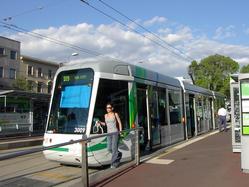
Comments on scenarios
I believe there are only two options realistically available for this transport corridor – the light rail enhanced rail scenarios. I am opposed to both bus-based scenarios because they fail to take into account issues such as our already congested roads, climate change, peak oil, and because they limit transport options within the Northern region.
It is positive to see improvements to the bus network under all four scenarios and believe this is another reason why diversified transport options such as light rail or enhanced rail are needed, rather than offering just one transport option to commuters.
I submit that two scenarios be investigated further – light rail and enhanced rail.
Scenario 1: Enhanced rail
I submit that this option be considered and investigated further.
I consider this option the second best of the four. However we see it as an uninspired stop gap measure that does not provide increased services or options to passengers and is only a continuation of what is currently available – though it does provide new and refurbished trains.
Rail is an efficient way to move large numbers of people along a corridor without a great deal of impact on roads, or a negative impact on society and the environment. Electric trains produce almost no noise or air pollution and can be powered on local energy supplies, unlike buses, which are reliant on imported fuel supplies from insecure sources. Having already developed rail infrastructure reduces the need for large-scale infrastructure improvements and the ensuing problems switching transport modes would cause during construction for passengers.
Rail is unable to provide a seamless service through to the CBD and this is a problem that has been identified since at least 1959 when a subway through the CBD was planned. With a price tag in the hundreds of millions for underground tracks from the railway station through to Taranaki St and Courtney Place, seamless rail travel is too expensive and cannot link in with the airport or hospital. Switching transport modes can be mitigated through smart design and integrated ticketing and is only one factor limiting the enhanced rail scenario.
Wellington is fortunate to have its rail infrastructure intact and despite years of under-funding, it is in relatively good condition. Wellington has a unique environment that is characterised by compact and defined geographical corridors with high population densities. This structure makes rail an efficient and popular means of travel along the corridor. Rail is considerably more popular than buses as a main transport mode and this is in large part to its perceived stability, superior comfort, reliability and speed.
Scenario 2: On-road bus with walking and cycling
I submit that this alternative is not investigated further or considered as a possible scenario.
I reject this scenario and see it as an unsustainable and dangerous path to go down. Relying on buses does not take into consideration possible future scenarios such as climate change, probable Central Government carbon taxes, peak oil and the end of cheap oil, and local pollution and exhaust particulates. Converting the railway line into a bike or walking track limits transport options for the residents who made approximately 3.1 million trips in 2005 and seems crazy when the 15% population growth expected is anticipated to see a 35% increase in public transport patronage for peak hour commuters.
I applaud identifying green belts, bike and walking tracks as desirable features of urban design however they cannot be at the expense of public transport modes.
Scenario 3: Busway
I Submit that this scenario not be considered.
Removing the rail lines is a crazy step backwards and would place Wellington with other cities around the world that removed tram, trolley bus or train infrastructure and are now regretting the decision and finding the massive infrastructure costs to replace tram, trolley bus and train infrastructure prohibitive. This scenario has many disadvantages, such as reducing transport options and reliability for Northern residents; it is in conflict with the Johnsonville transport hub design; it would increase traffic congestion, especially in Wellington city; and would cause massive disruption to commuters during construction; and lastly, it has serious negative environmental effects on local communities and the climate. Buses are dirtier, noisier and less popular than trains or light rail.
Ripping up the rail tracks is a foolish idea and damaging for our regions transport future. Rail tracks and stations provide and represent fixed certainty of transport mode options and encourage people to rely on those modes. In contrast, a busway could easily be reconstructed into a cycleway or greenbelt, limiting future transport options, and this uncertainty would reduce passenger support.
The busway is envisioned to be a one-way system catering for the morning and evening commute to Wellington city: not providing for passengers who travel from Wellington to the Northern suburbs. The busway cannot cater for all travellers and is likely to be confusing for passengers. Rail currently provides two-way transport and as such provides a better service.
Construction of the busway would cause massive disruption to Northern residents and may take 2–3 years. Unlike the light rail scenario, the busway construction cannot provide the inspiration or excitement of improved services, reliability and comfort that would mitigate the inconvenience of construction disruption. The modal switch necessary during construction may not return once completed.
Having buses as the only transport mode for the Northern region does little for already congested roads, especially on Lambton Quay, and would in fact increase road congestion – hardly a prudent public transport strategy. 30–40 buses could be necessary for this route, increasing congestion, and this would negatively affect return timetables and the reliability of service. Trains and light rail can carry more passengers efficiently, with fewer side effects and in more comfort than buses.
The major flaw in the two bus based options is relying on fossil fuel-based public transport. This is a major issue and must be addressed in the interests of sustainability. Public transport rates in the region have increased on average above 5% in 2006 as a result of increased fuel prices. Assuming that this current round of high oil prices is a temporary blip is neither smart, future-orientated nor sustainable. Diesel is a dirty, polluting and climate changing fuel source that comes from unreliable sources. The transport sector currently makes up 40% of our CO2 emissions in New Zealand and the Wellington region must do as much as possible to reduce its greenhouse gas emissions, both to help limit the risks of climate change and also as a matter of financial self-interest to avoid fuel price rises and probable carbon taxes. Alternatives such as an electric-powered trolley buses or using alternative fuels such as biodiesel to power the buses are possible but would need considerable research first, whereas the enhanced rail and light rail options utilise existing technology and infrastructure and are therefore more desirable.
The only thing going for the busway scenario is its cheapness, however, this does not translate to value for money. Trains can carry more passengers for the same price and are not subject to fuel price rises. It is easier to fix what we have got – an urban rail network, rather than build a whole new busway.
Buses will play a role in the Northern regions transport mix but more as an accompanying transport mode in areas of lesser population density not as the major public transport mode of the corridor.
Scenario 4: Light rail.
I submit that this scenario is the most sustainable and best suited to this transport corridor. I would like to see included in this scenario the light rail extension through to the airport.
I see this as the most desirable transport option because it is the cleanest, most sustainable and future-orientated transport mode of the four scenarios. It is also is the only option that would inspire and excite people, and would be one of the most important shifts of transport planning in our region’s history. Light rail offers the most holistic strategy and would benefit residents and commuters both in the Northern suburbs and in Wellington City. The ability to provide seamless travel is one advantage and light rail offers services that will be frequent, reliable and it will be the most sustainable alternative and as such, is the most preferred scenario.
Light rail has considerable advantages over its competitors. It is modern, flexible and compatible both on existing rail lines and within urban environments such as pedestrian malls or on roads. Compared to heavy rail it is flexible, more adaptable and can negotiate curves and gradients better. Light rail trams are attractive and do not emit street level particulate or produce noise pollution benefiting both Northern residential communities, and also the commercial district
A major disadvantage of this alternative is its cost; 138–146% of LTCCP funding for public transport on the Northern suburbs. However, this needs to be put in perspective; that operating costs would be less than its alternatives, it has considerable environmental positives associated and is both part of Northern and Ngauranga to airport corridor investigations. The 15 June 2004 Waterfront Conference on light rail found that it was the most economical long term transport solution for routes carrying in excess of approximately 3000 passengers per hour. It is also a major investment in a new transport mode and as such does not come cheap, but we consider it value for money.
I believe in future proofing our society against potential shocks and see our transport dependence on oil as a liability. The light rail scenario utilises national electricity supplies that are predominately renewably sourced; and if Project West Wind is built, we will have a light rail network reliably running on our regions famed asset – the wind.
Conclusion
The scenarios report can only include two real options –light rail and enhanced rail. The bus options do not make sense and are only cheap short-term solutions. We are fortunate to have a rail network and it would be a massive disservice to future generations to rip up an efficient and popular line.
The light rail scenario will give Wellington the clean, dynamic transport system it deserves; a pollution-free passenger transport network powered by wind and other forms of renewable energy. If implemented, it will make Wellington one of the easiest places in the world to get around in. It will encourage smart, sustainable growth throughout the Northern region. This corridor is an essential part of the entire Wellington region, and light rail would be part of making Wellington a world leader in sustainable urban transport, well equipped to cope with the realities of soaring oil prices, climate change and similar inescapable issues.
Light rail builds on our region's strengths – its compactness, existing electric transport infrastructure and clean, renewable wind energy.




 nessed a large man-sized coral ‘tree’ being dragged up and thrown overboard, and have heard anecdotally from former trawlers that for every 4 tonnes of orange roughy caught, 10 tonnes of coral will be brought up. Dead.
nessed a large man-sized coral ‘tree’ being dragged up and thrown overboard, and have heard anecdotally from former trawlers that for every 4 tonnes of orange roughy caught, 10 tonnes of coral will be brought up. Dead. 













